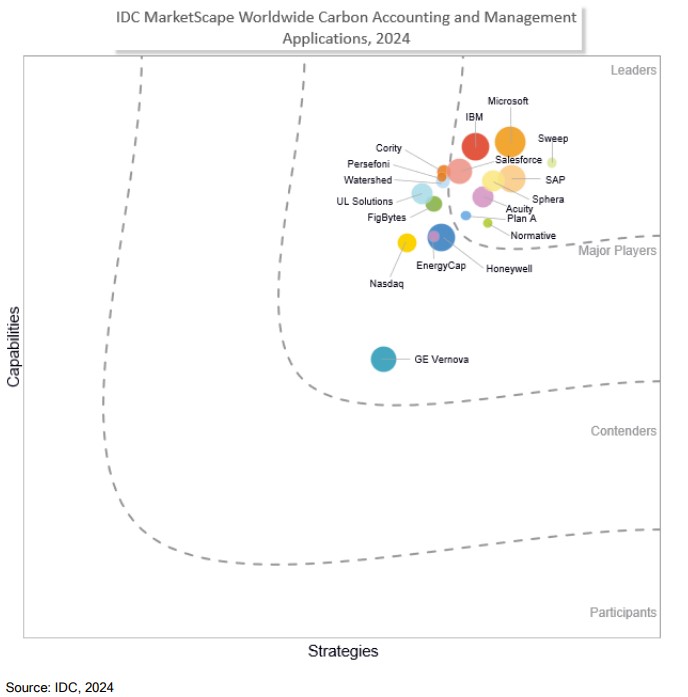SAP has been named a leader among 18 vendors in the first-ever IDC MarketScape: Worldwide Carbon Accounting and Management Applications 2024 Vendor Assessment.
A once nascent market, carbon accounting and management is experiencing a significant transition in the number, type, and capability of solutions available. The landscape formerly comprised of startup and niche vendors has expanded to include large independent software vendors (ISVs) and hyperscalers, all battling for market share.
Organizations are under increasing pressure to track and disclose carbon emissions data to stakeholders including investors, partners, clients, customers, employees, and regulators. Many are collecting data and reporting on Scope 1 and 2 emissions. Scope 3 remains a challenge due to the complexity of reliable data collection and reporting.
Fines and litigation will create a new impetus for reporting as well. Regulations will add a new element of complexity to how companies report. Disclosure of decarbonization initiatives will require unique data analysis and scenario planning tools. The IDC report points to data integration as a principal challenge for carbon accounting vendors.

The IDC MarketScape vendor analysis model is designed to provide an overview of the competitive fitness of ICT suppliers in a given market. The research methodology utilizes a rigorous scoring methodology based on both qualitative and quantitative criteria that results in a single graphical illustration of each vendor’s position within a given market. The Capabilities score measures vendor product, go-to-market and business execution in the short-term. The Strategy score measures alignment of vendor strategies with customer requirements in a 3-5-year timeframe. Vendor market share is represented by the size of the icons.
SAP Carbon Accounting & Management: Rising to the Challenge
SAP is well-positioned to provide organizations with data-driven, purpose-specific carbon management solutions that are ERP centric, cloud based, and AI enabled. These include SAP Sustainability Footprint Management, SAP Sustainability Control Tower, SAP Sustainability Data Exchange, the SAP S/4HANA Cloud solution for EHS environment management, and SAP Green Ledger, which all help to enable carbon accounting and management on a transactional level and transform emissions tracking processes.
Our carbon management solutions are best suited for organizations currently using or planning to use SAP S/4HANA Cloud and looking to capture the value of sustainability, as well as manage sustainability-related business risks. Customers can address these objectives by embedding sustainability into their end-to-end business processes, leveraging ERP and supplier data, and using the metrics to inform business processes and financial reporting.
Having the ability to assess carbon and financial data on the same transactional level adds a new dimension to the way organizations address carbon budgets, make capital allocation decisions, and cascade and scale change management. This transformation allows for targeted sustainability actions and more precise financial decisions.
SAP can leverage its ERP-centric sustainability approach of supporting both corporate and transaction-level product carbon footprints as a differentiator. Integration with other financial applications – procurement, supply chain, risk, and compliance management – is a standard feature of the SAP Sustainability portfolio.
Staying ahead of carbon taxes, penalties, and upcoming regulatory requirements will also play a key role in how organizations report. Alignment between CFOs and CSOs will become more frequent due to the overlapping responsibilities and sustainability management component, as they affect both corporate risk and cash flow.
According to the IDC MarketScape, “the portfolio of sustainability offerings is built on a foundation of SAP S/4HANA Cloud, limiting adoption to the universe of users. Furthermore, while modular in design, much of the solutions’ value is dependent on the adoption of multiple system elements, thus commanding a higher price point.” SAP is responding with the speed and agility of cloud delivery combined with integrated sustainability data within the core enterprise resource planning system. This will be critical in helping to optimize customers’ sustainability and financial performance and become the very foundation of their future business success.
By unifying sustainability and financial data, SAP customers can unlock carbon emissions insights, positively impacting decision-making and forecasting on all hierarchical levels. With end-to-end carbon management and the added transactional-level carbon emissions data, organizations can improve operational efficiency, foster emissions transparency, and comply with developing regulations. Achieving a sustainability transformation – one that benefits the bottom line and the planet – is truly within reach. Find out more here.
The IDC study provides a comprehensive analysis of carbon management platforms, highlighting the increasing need for organizations to track, manage, and report carbon emissions amid evolving regulatory landscapes and stakeholder pressures. It evaluates vendors based on their capabilities and strategies to meet future customer needs, focusing on innovation, customer satisfaction, and the ability to support organizations in their decarbonization efforts. “In an era of escalating environmental scrutiny, mastering carbon accounting is not just compliance, but a strategic imperative for future-proofing businesses,” said Amy Cravens, research manager, ESG Reporting and Management Applications at IDC.
Alicia Lenze is global head of Sustainability Marketing at SAP SE.
